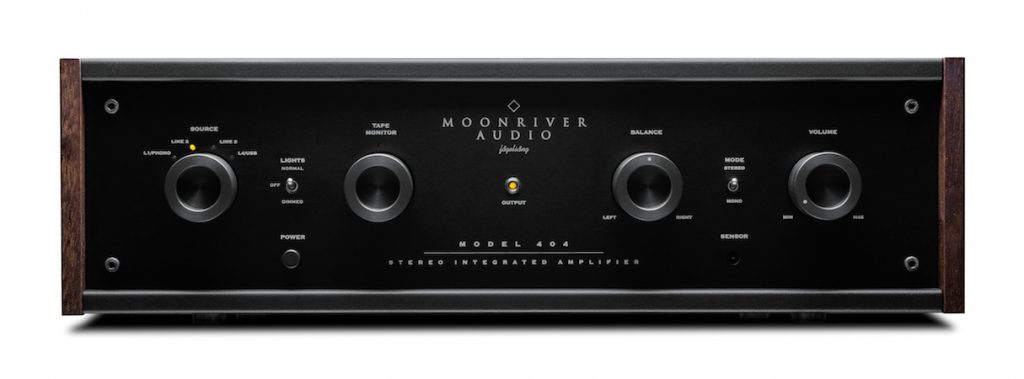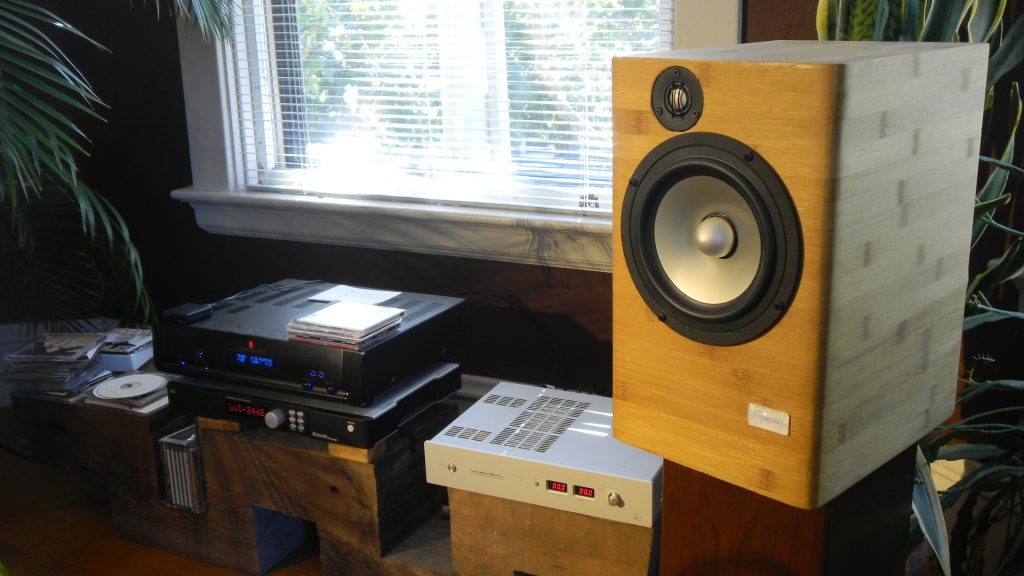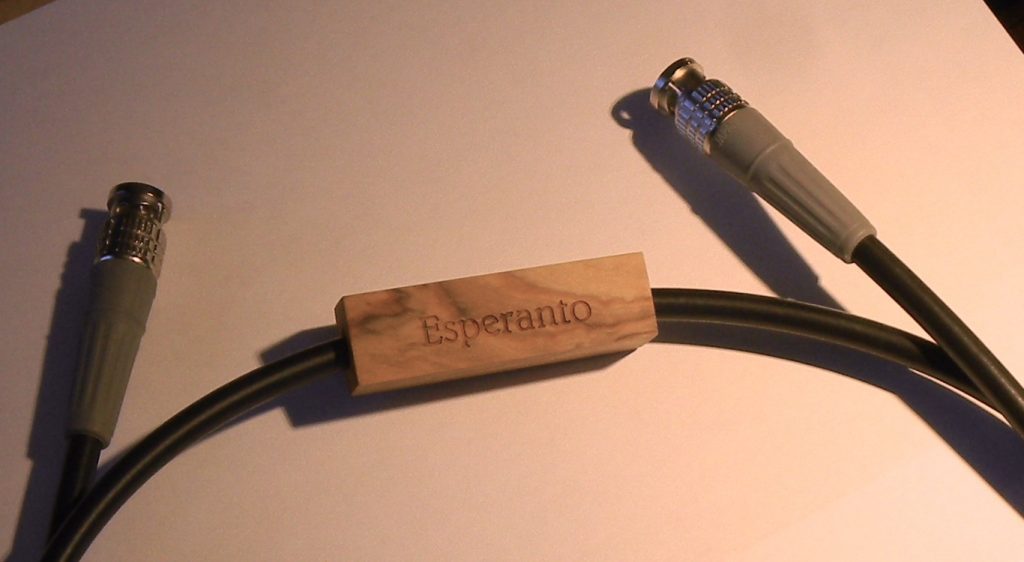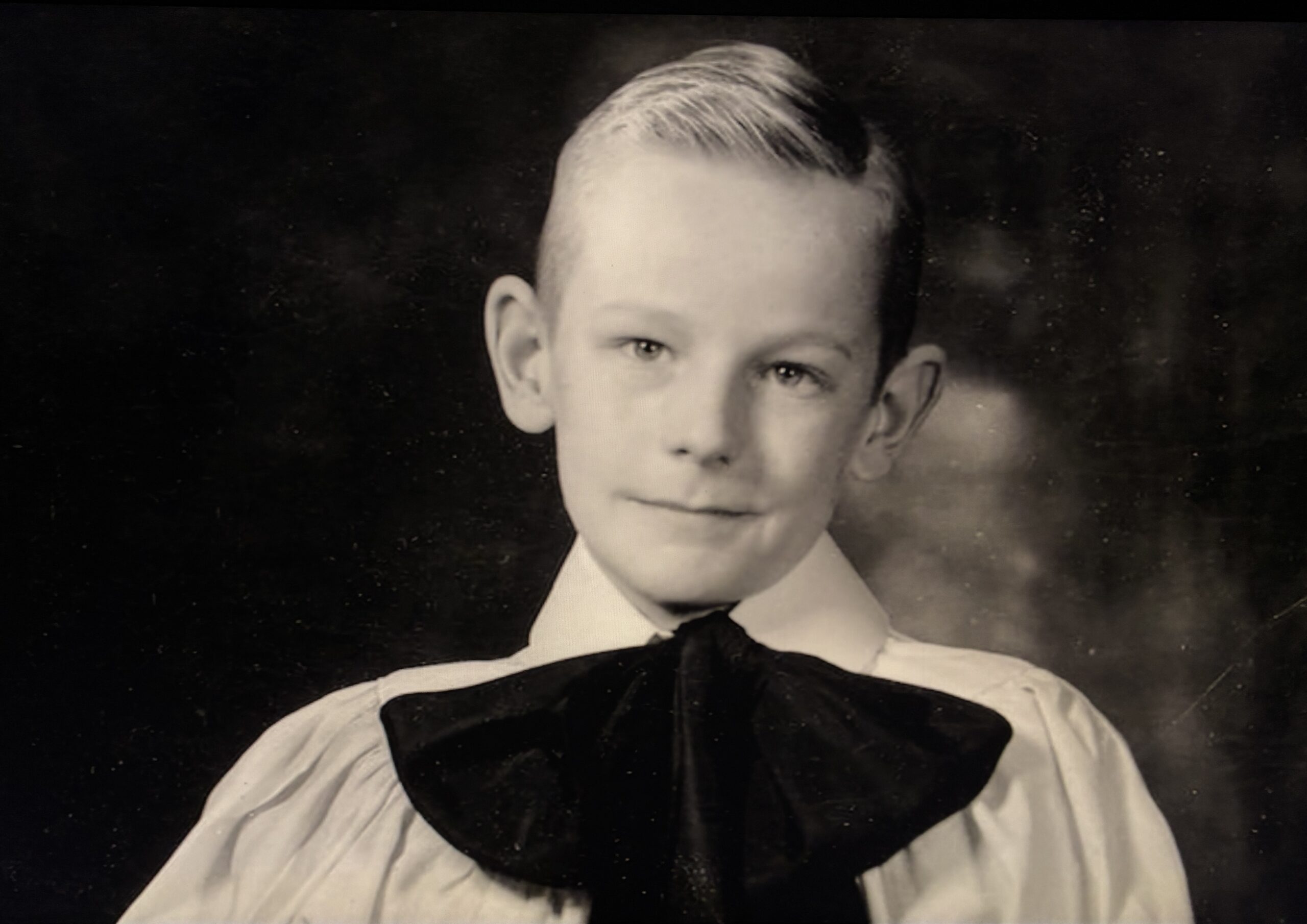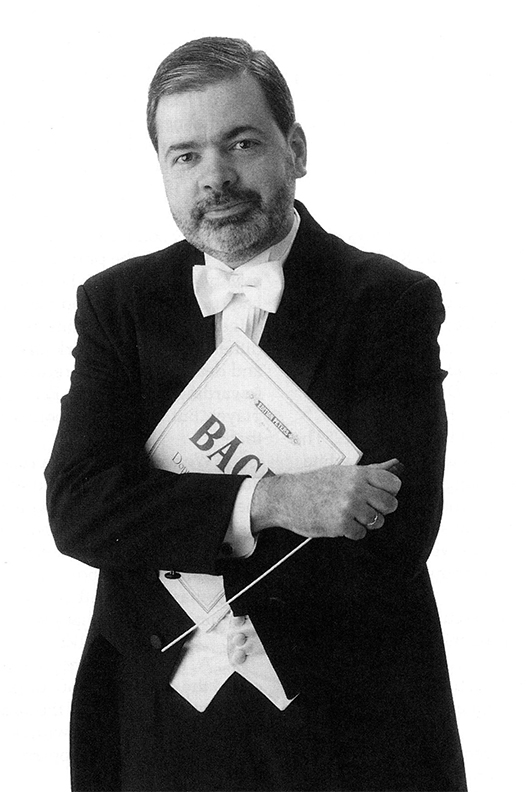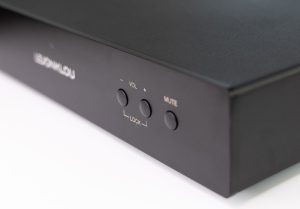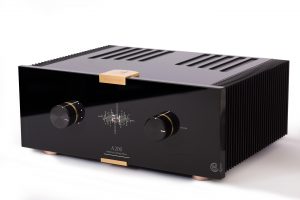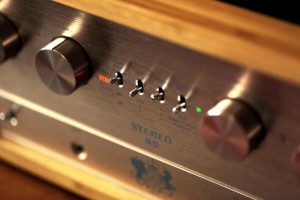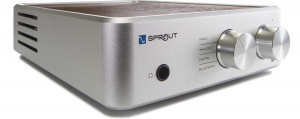Once again, our great friend and music lover, John Marks, Editor of The Tannhauser Gate, has favored us with his reflections...this time on the Moonriver Audio Model 404. As usual, John writes with great knowledge and discernment on the audio virtues of this integrated amplifier. Read, and learn! Dr. David W. Robinson, Ye Olde Editor
The Moonriver Audio Model 404 is a solid-state stereo integrated amplifier with a rated output of 50 Watts per channel. The Model 404 combines a preamplifier stage that consists entirely of discrete devices (and therefore, there are no integrated-circuit chips in the preamplifier), and a power-amplifier stage that is Class A/B linear (and therefore, the Model 404 is not a Class-D digital-switching amplifier).
The company name of Swedish high-end-audio newcomer "Moonriver Audio" is a tribute to the song "Moon River," from the Audrey Hepburn (1929-1993) film Breakfast at Tiffany's. "Moon River" won for Henry Mancini (music) and Johnny Mercer (lyrics), the 1962 Academy Award ("Oscar") for "Best Original Song." (The screenplay was based on a novella by Truman Capote. He cried all the way to the bank.)
Therefore, the first important point is: the Moonriver 404 is hand-built in Sweden, apparently by someone who has fond memories of Audrey Hepburn.
(And so, therefore, the Moonriver 404 is not built in China by people who—most likely—do not have fond memories of Audrey Hepburn.)
The second important point is that the Moonriver 404 (US MSRP $3500; but there are optional modules) is a tremendously serious audio product. As far as I can tell, the Moonriver 404's only "flaw" is that it never calls attention to itself. However, that's because it only calls attention to the music.
More on what I mean by "a tremendously serious audio product," after the jump. And more about Audrey Hepburn!

Image © Paramount Pictures
When she was a child in school, Audrey Kathleen Ruston was known as "Edda van Heemstra," because Holland was then under Nazi occupation. Audrey's (aristocratic) Dutch mother wanted to lower Audrey's British profile by raising her Dutch profile.
At some point, Audrey's father added "Hepburn" to his name, to keep that particular family name from dying out. Audrey's legal surname followed suit. However, for her professional name, Audrey chose Hepburn alone, rather than Ruston (or, the two last names, joined by a hyphen). Perhaps that was because "Hepburn" supposedly had a more interesting history. Hepburn was the name of Mary, Queen of Scots' third husband.
Or, perhaps, Audrey just wanted to distance herself from Daddy, because Daddy was a "British Fascist" who had abandoned his family when Audrey was six. (With the predictable consequences visited upon an innocent child.) It seems Daddy scampered to devote all his energies to the Bright Fascist Future.
Audrey Hepburn sang the vocal track that is used in the film Breakfast at Tiffany's fire-escape scene. However, ironically enough, when RCA released a 45-rpm single, it was a treacly, instrumental-with-mixed-chorus version. There was no Audrey in it.
I say that's ironical because, during the final editing of the film, one important movie-studio executive offered the opinion that the song "Moon River" (and, I assume, that entire scene) had not been well-received in previews (which today, we would call "focus groups"); and so, the song should be cut.
Hepburn's prompt reply was, "Over my dead body"— or, perhaps something a little stronger.
"Moon River" was a song that had been at risk to be deleted from Breakfast at Tiffany's. But then, Audrey Hepburn's on-screen singing turned it into a surprise hit that became an enduring "standard."
Therefore, I can only think that she must have been crushed, a year or two later, when the producer (or whomever) of the film version of My Fair Lady decided that the vocal tracks that Hepburn had recorded were too weak. Marni Nixon re-recorded almost everything that Hepburn had sung.
Audrey Hepburn belongs to the exclusive EGOT club: she won at least one each of the Emmy, the Grammy, the Oscar, and the Tony awards. However, I think that she would probably prefer to be remembered for her humanitarian work, to which she applied herself with the same determination as she had shown in her ballet studies and in her career as an entertainer.
A final Audrey Hepburn trivia bit:
From her teenage years, Hepburn trained as a ballerina. And so, of course, she was thin, and muscular. However, she was also self-conscious about what she thought of as her "washboard" upper chest. She therefore asked her friend, the designer Hubert de Givenchy, to design a simple dress that would cover up that area. The Breakfast at Tiffany's opening-scene dress was not the first "Little Black Dress;" but it is, by far, the most famous.
Many years later (2006), Givenchy, the designer of the dress, gave one of the two original dresses made for the film (and apparently, the only surviving one) to Dominique Lapierre and his wife. Lapierre had written the book The City of Joy, about the poorest of the poor in Calcutta. Givenchy intended that the Lapierres would auction the dress off, to support their charitable activities.
At auction, Givenchy's original Breakfast at Tiffany's dress fetched $923,187.
The Lapierres built a school in Calcutta with the proceeds. God bless them all.
(By the way, the Moonriver Audio Model 404 may be black, but it is not little!)
Perhaps the best way for me to explain what I mean by "a tremendously serious audio product" is to point out an example of what appears, to me, to be the opposite.
If you browse on Amazon, you can find a "stereo receiver" by Sony selling (new) for $148. With free shipping. It claims a rated output of 100Wpc (!!!); it has a phono input; it has 30 FM-radio channel presets; and, it is Bluetooth-enabled.
I do understand that such a product might (to some extent) meet a need, while keeping the cost as low as possible. However, I don't think that the laws of physics (or the laws of economics), will allow the Sony STRDH190 to meet the needs of serious music lovers who want to listen to recorded music as the main focus of their attention, awareness, or concentration.
By the way, back in the day, an insider at Bose told me that the (pre-CD model) Bose Wave Radio (retail $395) cost Bose $35 on the OEM factory's loading dock, in Taiwan. I don't think that the Sony receiver at $148 has that kind of profit margin; but it must have some kind of a profit margin. What does it cost to make? $75, all-in (including the box and the User Guide)?
Enough of that.
One of the audio beliefs I arrived at, quite a long time ago, is that power amplifiers that have the absolute minimum of output devices per channel have a decided sound-quality advantage over amplifiers that have many output devices per channel. darTZeel's NHB-108 solid-state stereo power amplifier is perhaps the highest-end's best-known example of that. But IIRC, Plinius' SA-50 similarly had one pair of complementary solid-state output devices per channel.
I believe that what is going on there is, that by having the smallest possible number of output devices per channel (which is the case with the Moonriver Model 404), such a design avoids the "timing errors" of multiple power transistors' jumping up from a resting state to some degree of power-on, with some non-trivial variability in rise times.
Note well, the output devices in the Moonriver 404 are "power modules;" but there is only one power module per channel, hence the 50-Watt power rating. Chief designer George Polychronidis chose power modules in the interests of safety, reliability, and repair-ability. And I do not disagree at all.
Safety, at times, is at risk of becoming a non-priority in consumer-electronics design. IMHO there is absolutely no excuse for that kind of corner-cutting in high-end audio. Years ago, I received, in sequence, as review samples, three identical (IIRC) 120Wpc amplifiers from a manufacturer that today I don't know whether is still in business (Perreaux).
Each amplifier had a few hours running time on it. Then, they all made a huge popping sound through the loudspeakers, and went into full thermal runaway. While emitting acrid odors. Fortunately, I was in the room, all three times. Stereophile‘s "Sam Tellig" narrowly averted a house fire when a (US-importer-hot-rodded) Jadis amplifier caught fire.
But the Grand Prize goes to Krell. The US Consumer Products Safety Commission had a word or two with them about a troubling number of electrical fires. More than 2,000 amplifiers were recalled. (You can look that up for yourself, if you think my link is "Fake News.")
Contrast all that, with what George Polychronidis told High Fidelity Poland:
Additional benefits [of power modules] are that they are extremely stable—electronically and thermally; that they have very short signal paths; that the transistor halves are laser-trimmed; and they include all the protections like thermal shutdown, servo DC offset, over-voltage protection, short-circuit protection, etc. They offer a level of safety that you can't get with discrete designs.
(Emphasis added.)
A complex, multiple-devices output stage can be like a chorus that is trying to sing absolutely together, but not quite succeeding. I would also speculate that large amounts of negative feedback would only make that timing problem worse.
Which calls to mind the venerable Shibboleth that, "In audio, not everything that can be measured is important; and, even more importantly; not everything that is important can be measured." Such is the case with "timing errors." I think that in some amplifiers, you can hear a certain "temporal blurring" that other amplifiers don't seem to exhibit, but I am not aware of any way to measure that.
Another of the audio beliefs I arrived at, quite a long time ago, is my (not entirely tongue-in-cheek) claim that the primary purpose of the audio signal path in a power-amplifier design is to let us know how good the amplifier's power supply is!
That's because the basic scheme of a power amplifier is to act like a "valve," in that a smaller voltage (the input) is used as a control mechanism to modulate a far-greater voltage (the power supply).
Which brings us to the seriousness of the Moonriver 404.
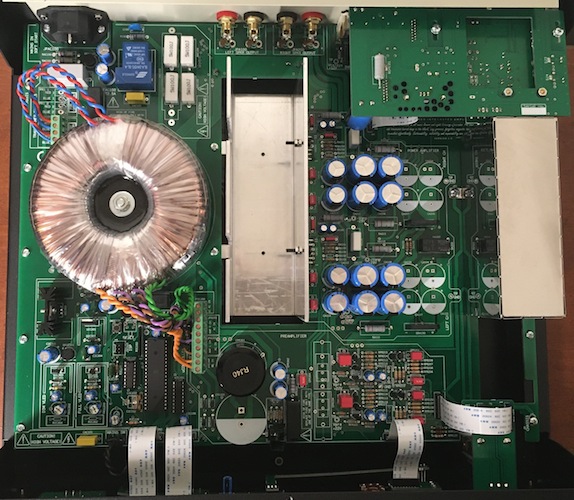
Photo by John Marks
First, the Moonriver 404 is surprisingly solid and heavy (circa 28 pounds). To me, that indicates that the power-supply components, such as transformers, capacitor banks, and bus bars, are hefty. Not considering the optional modules, the Moonriver 404 has five separate power supplies. By the way, all the electronic sub-components are through-hole devices; there are no surface-mount devices. That is in the interests both of reliability and repair-ability.
Great care has been taken in power-supply design and isolation. As one example, I was pleased to learn that the optional USB digital-to-analog converter module (which goes inside the amplifier's case, with a USB jack on its back panel) is not powered by the USB power supply of the device (such as a laptop computer) that the DAC module is connected to. The DAC module supports PCM streams up to 384kHz.
The Moonriver 404's optional DAC module is powered internally, from within the amplifier, and with separate power supplies for its digital and analog stages. Impressive! That also means that in choosing a USB cable, you don't need to take into account that cable's power-filtering performance, because no power will be going up that USB cable, only data.
The USB-only internal DAC option is $650. There is also a choice of two optional internal phono modules (MM only, or MM/MC), which I did not request.
In addition to the usual Power button and Source-selection and Volume controls, the Moonriver 404 has a Mono/Stereo switch, a center-detented Balance control knob, an Output light and a Source light (both on one dimming switch), and a Tape Monitor control knob. It appears that the Source selection is actuated by relays. In addition to the Tape Monitor loop, there are two sets of preamplifier outputs.
There is no front-panel headphone jack, and I did not miss it. Perhaps, if there is customer demand, Moonriver Audio can offer a stand-alone, plug-in-to-the-wall DAC/HPA/Pre unit. I am not at all sure there will be any demand for such a thing, because it seems to me that the target audience is sit-down, at-home, loudspeaker listeners.
The loudspeaker binding posts are sturdy, and are of very high quality. There is an undistinguished remote control, which is slated for upgrading. The front-panel Power button operates a 30-amp relay; that sub-system is designed to have a working life of at least 20 years. Impressively robust engineering is found everywhere in this product. The Moonriver 404 is very serious about delivering excellent value for money. The amplifier as a whole carries a three-year warranty.
The inclusion of the Tape Monitor loop, Balance control, and Mono/Stereo switch demonstrate to me that the Moonriver 404 was designed with careful thought having been given to the actual needs of, and the "user experience" of, the music lovers who will buy it. For example, the Tape Monitor loop enables the use of an outside analog equalizer, or a digital room-correction device.
Inextricably intertwined with the thoughtfulness of the design (or, at least, that seems to be the case to me), is that Moonriver, consciously or unconsciously, in terms of the "Functional Æsthetic," went "Forward, to the Past." By providing so many hard-wired knobs and switches, Moonriver turned their backs on the "modern" ideas of controlling an audio component by means of a touch screen, or a single, rotate-and-push, knob.
My overall impression is that Moonriver Audio has created a bombproof powerhouse of an updated "Golden Age of Audio" integrated amplifier. Or, a "New Old School" vintage "Stereo Receiver," such as the wood-cased Marantzes of the 1970s. Indeed, the 404's industrial design includes the gesture of solid-walnut corner pieces for its front panel.
I can easily imagine someone's being very happy with a high-quality (but, in the grand scheme of things) affordable turntable (such as the Rega P3 package) and a Moonriver 404 with an internal phono-stage option, and nothing else, apart from the loudspeakers.
I can also imagine that person's being especially glad to have the Mono switch. I often used the Mono switch while listening to Qobuz streaming of mono recordings from 1950s singing stars such as Ella Fitzgerald, Helen Merrill, and Julie London.
I also must note that the Moonriver 404 sounded a lot more powerful than its stated 50Wpc. I tried the 404 with four, quite different loudspeakers. First, the Graham Audio Chartwell LS6 revival. Then, a vintage pair of Atelier de Synergie Acoustique (ASA) "Baby" Studio Monitors (about which the Customs Inspector exclaimed, "Hey! These aren't Baby Monitors!!!"—a true story).
Next, the prototype pair of Esperanto Parolantos, a Mike Zisserson design with a little bit of input from me. Finally, JBL's L100 Classic revival.
With all those loudspeakers, I hardly ever moved the 404's volume-control knob past the 9:00 position. I never pushed the volume knob past 12:00. There were times I listened very loudly, going well over 90 dBA on the NIOSH iPhone sound-level-meter app. It was glorious to listen to "Guilty Pleasure" tracks such as Sade's "Smooth Operator" and Boston's "More Than a Feeling," so loudly and clearly. And with such powerful bass!
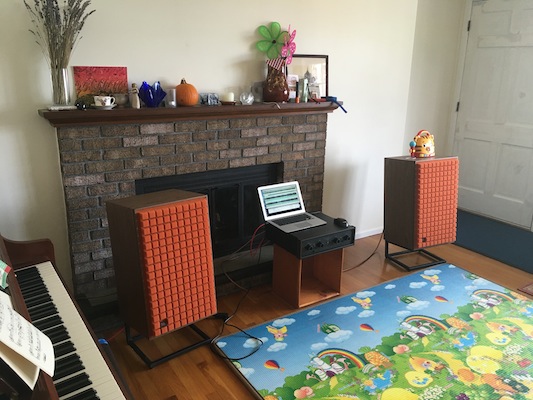
Photo by John Marks
The JBL L100 sure knows how to dominate a room! Visually and sonically. A review of the L100 will follow in due course. But even playing very loudly, the Moonriver 404 never showed any signs of strain while driving a pair of 12-inch woofers.
The setup photo shows how I usually listened, the source being Qobuz digital streaming (as often as possible, in high resolution, up to 384kHz) played from a MacBook Air laptop computer. USB cable and loudspeaker cables were both from WireWorld, and both are truly excellent (review to follow).
While each of the four pairs of loudspeakers (of course) sounded rather dissimilar as one would expect (JBL and Chartwell, for instance); on all the loudspeakers, certain performance characteristics of the Moonriver 404 were consistent. I have already noted that it sounded more powerful than 50 Watts. It was also very dynamic, from the smallest gradations of chamber music, to large-scale orchestral works.
However, I think that the most important characteristic is the coherence of the sound. I don't want to use the word "smoothness," because that might give the impression of rounded-off highs. The highs are not rounded off. And that's certainly not what the designer intended, because the small script word "fågelsång" on the front panel means "birdsong."
There is a very organic "togetherness" to the sound. Both in the time domain, and in the frequency domain.
Because I was putting together some Qobuz playlists (as well as hosting a few small, mask-wearing listening parties), I listened to hundreds of tracks through the Moonriver 404; but I don't want to inundate you with that kind of list.
So I will just report on what, for me, was the single most impactful thing I heard—the Qobuz high-resolution (24-bit, 44.1kHz) version of Joel Frederiksen and Ensemble Phoenix Munich's Requiem for a Pink Moon, which is an Elizabethan-instruments tribute to the music of 1970s UK singer-songwriter Nick Drake.
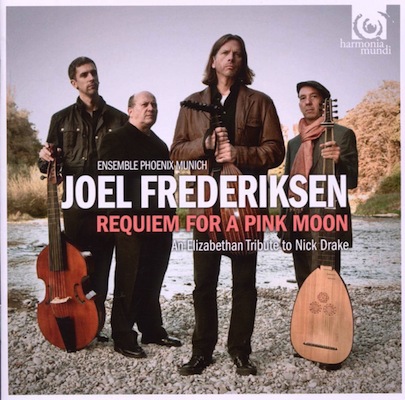
I hasten to point out that bit depth is far more important than sampling frequency. So please don't turn your nose up, especially without listening, simply because what Qobuz has on offer is 24/44.1, rather than 24/96.
I have listened to the CD version of Requiem for a Pink Moon a lot—I wrote it up for The Tannhäuser Gate HERE. However, the 24/44.1 streaming files, through the Moonriver DAC module and the Graham Chartwell L6es, were a revelation.
Qobuz has a 30-day free trial; therefore, I urge you to check out Requiem for a Pink Moon.
Here's the Qobuz link to Requiem for a Pink Moon.
After one of the listening parties, one participant remarked that it was a true measure of how great an audio product the Moonriver 404 is, that nobody really had any comments to make about it. They just listened to it, and enjoyed the music.
To sum up: Highest Recommendation.
Moonriver Audio Model 404 Stereo Integrated Amplifier
Retail: $3500 (without options)
Country of Origin: Sweden
Distribution for the Americas:
San Juan Capistrano, California USA
949.544.1990




